Best Camera And Lens For Wildlife Photography
The fact is that wildlife tends to move all the time and hide in the most annoying and dark places, so the wildlife lens should be optically fast and excel in low light conditions.
The best lens for wildlife photography comes with fast focusing, sharp images, and large focal length. Here are our favorites.
We Recommend
Best Lens for Wildlife Photography
1. Sigma 150-600mm f/5-6.3 Contemporary DG OS HSM Wildlife Lens
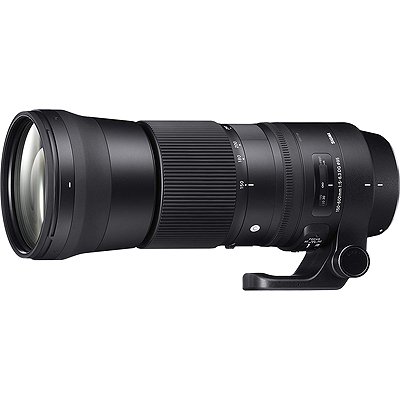
The Sigma 150-600mm f/5-6.3 Lens is an impressive lens at its price point.
The most alluring feature of this lens is its zoom. At 600mm, photographers are sure to capture some incredible close-ups of wildlife in action.
The image stabilizer is also very reliable, which helps this lengthy lens produces sharp images even when photos are taken from a handheld position.
The Sigma 150-600mm f/5-6.3 Contemporary DG OS HSM Lens is perfect for beginner bird photographers looking to improve their photography by prioritizing a high focal length range.
The lens performs very well and produces great photos up to 400mm. When the lens is maxed out at 600mm, image sharpness is reduced, but overall the lens is a great addition for amateur wildlife photographers.
Best for: Wildlife Photography
Matching camera body: Canon EOS REBEL T7i DSLR Camera
What we liked
- Great, Affordable Lens
- Impressive Telephoto Reach Maxing Out at 600mm
- Includes Tripod Collar and Lens Hood
- Quiet and Fast AF
- Excellent Sharpness at 400mm and lower; Good Sharpness at 600mm
- Good Image Stabilization
What we didn't like
- Not Fully Weather Sealed
- Chromatic Aberration at High Zoom
- Somewhat Heavy
Focal Length: 150-600mm
Aperture: f/5-6.3
Format: Full-Frame
Type: Hyper-Telephoto Zoom
Autofocus: Hypersonic Motor AF
Stabilization: Optical Stabilizer
Glass: 1 "F" Low Dispersion (FLD) Element and 2 Special Low Dispersion (SLD) Elements
Weight: 4.25 lbs
Warranty: 1-year North & South America Warranty, plus 3-year Extended USA Warranty
2. Canon EF 100-400mm f/4.5-5.6L is II USM Telephoto Lens

The Canon EF 100-400mm f/4.5-6.5L IS II USM Lens is a fantastic lens that can take incredible photos.
This lens is solidly built and includes a fast and quiet AF system using an ultrasonic motor. The aperture range is quite good, considering the focal length range.
The fluorite glass element, paired with a UD element, is also a great upgrade that improves image quality and camera speed.
This particular lens is a popular choice among advanced wildlife photographers who want a dynamic lens that can be useful in a variety of environments. Photographers will have no problem taking great pictures of wildlife with this camera.
Best for: Advanced Bird and Wildlife Photography
Matching camera body: Canon EOS 6D Mark II Digital SLR Camera
What we liked
- Focal Length Allows for Flexibility while Shooting
- Close Focus at 3.2 ft
- Solid, Weather-Sealed Build
- Fast and Quiet USM AF
- Compatible with Certain Canon Extenders
- Very Sharp Images at All Focal Lengths
- The Foot of Tripod Mount can be Removed
What we didn't like
- Low-Light AF can Lag
- Can't remove the Entire Tripod Mount
Focal Length: 100-400mm
Aperture: f/4.5-5.6L
Format: Full-Frame
Type: Telephoto Zoom
Autofocus: Ultrasonic Motor AF
Stabilization: Optical Image Stabilizer with 4-Step Image Correction
Glass: 1 Fluorite & 1 Super Ultra-Low Dispersion (UD) Element
Weight: 3.4 lbs
Warranty: 90-day Warranty for Renewed Items
3. Nikon AF-S FX Nikkor 200-500mm f/5.6E ED Wildlife Lens
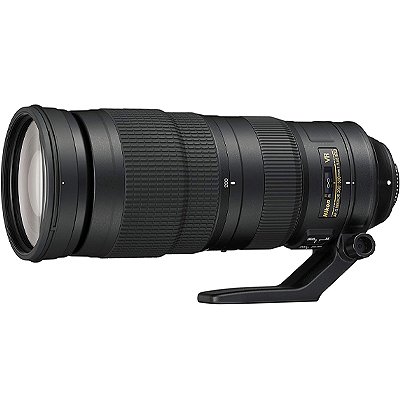
An impressive lens, to say the least, the Nikon AF-S FX Nikkor 200-500mm f5.6E ED Lens is a high-performance super-zoom telephoto lens that guarantees great shots.
Wildlife photographers and bird photographers will be grateful for the picture clarity this lens produces at high focal lengths.
What's perhaps even more impressive is the fact that this lens is 5 lbs, but it doesn't feel like an inconvenience.
The lens body is well balanced, which is a huge plus for photographers planning on trekking around with this lens in hand.
At its price, this lens seems to be geared toward the advanced bird and wildlife photographers, but anyone would be able to identify the remarkable picture quality that the Nikon AF-S FX Nikkor 200-500mm f/5.6E ED Lens produces.
Best for: Advanced Bird and Wildlife Photography
Matching camera body: Nikon D500 DX-Format DSLR Camera
What we liked
- Incredibly Sharp Photos Even at High Zoom
- Great Vibration Reduction
- Solid Build Quality
- Well-Balanced, Despite the Size and Weight
- Fixed Aperture throughout Focal Range
- Removable Tripod Collar
What we didn't like
- Well-Balance, but Still Heavy
- Somewhat Slower Focus in Low Light
Focal Length: 200-500mm
Aperture: f/5.6E
Format: FX
Type: Super Telephoto Zoom with Constant Aperture
Autofocus: Silent-Wave Motor AF
Stabilization: 4.5-Stop Vibration Reduction IS
Glass: 3 Extra-Low Dispersion (ED) Elements
Weight: 5 lbs
Warranty: 1-year Limited Warranty
4. Canon EF 70-300mm f/4-5.6L IS USM UD Lens
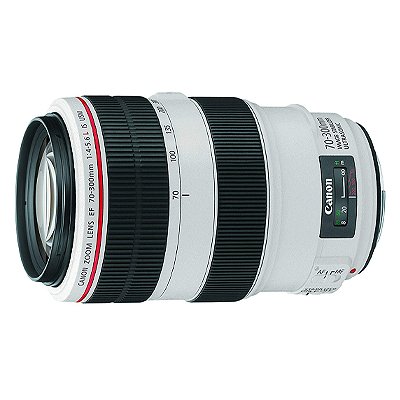
The Canon EF 70-300mm f4-5.6L IS USM UD Lens is a great starter lens for wildlife photographers.
This lens features a versatile zoom range that allows photographers to get close-ups of wildlife.
It also allows photographers to zoom out to get views of the surrounding landscape. With an aperture that maxes out at f/4, this lens performs well in low-light.
Its fast autofocus is also a great plus for wildlife photographers who must track animals as they move about the frame.
The Canon EF 70-300mm f4-5.6L IS USM UD Lens is a great lens for amateur wildlife photographers looking for a lens that can be adapted to shoot in many different settings. It's AF and aperture allow it to produce sharp images throughout the focal length range.
Best for: Beginner Wildlife Photography
Matching camera body: Canon EOS 7D Mark II Digital SLR Camera
What we liked
- Sharp at Every Focal Length
- Build Quality
- Great 4-Stop Image Stabilizer
- Smooth Focus Ring with Twist Zoom
- Weather Sealed
- Fast AF
- Designed for Full-Frame, APS-C, and APS-H Cameras
What we didn't like
- Not Compatible with Extenders
- No Tripod Collar
- White Color Makes it More Conspicuous
Focal Length: 70-300mm
Aperture: f4-5.6L
Format: Full-Frame
Type: Telephoto Zoom
Autofocus: Ultrasonic Motor AF
Stabilization: 4-Stop Optical Image Stabilization
Glass: 2 Ultra-Low Dispersion (UD) Elements
Weight: 2.3 lbs
Warranty: 1-year Limited Warranty
5. Nikon AF-S FX NIKKOR 80-400mm f/4.5-5.6G ED VR Zoom Lens
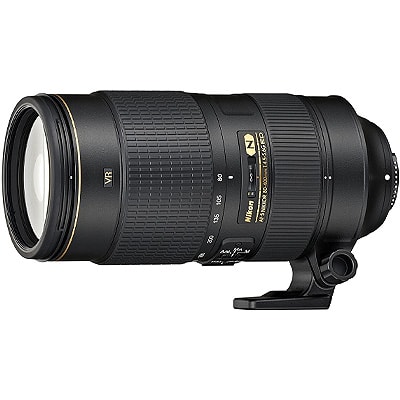
The Nikon AF-S FX NIKKOR 80-400mm f/4.5-5.6G ED VR Zoom Lens is a product that offers a professional photography experience at a lower price point than many competitors.
It is a great option when looking at the best lens for wildlife photography Nikon has to offer.
The lens comes with an aperture range of f/4.5 to f/5.6.
You can adjust the aperture according to the environment you are taking a shot in. Focal length can also be adjusted within the range of 80mm to 400mm, depending on the needs of your photography session. This is an essential feature when buying the best wildlife lens for Nikon.
The Nikon 80-400mm Zoom Lens features an FX-format compatible system and an F Bayonet mount type. The wide aperture helps you get better precision. It has a minimum focusing distance of 5.7 feet. These wildlife photo lenses also come with a built-in autofocus system.
Image stabilization is provided in the format of vibration reduction. This can help to reduce motion blur. The wildlife photography lens does have a heavier weight than some of the alternatives, which is something you should take into account.
Best for: Shooting large areas
Matching camera body: Nikon D750 FX-Format DSLR
What we liked
- Autofocus functionality
- Tripod collar included
- Vibration reduction
- Adjustable aperture
- Adjustable focal length
- FX-format compatibility
- Nikon F Bayonet mount
What we didn't like
- Heavier than alternatives
- Higher price tag
Focal length:80-400mm
Aperture:F/4.5-5.6G
Format:AF-S
Type:Nikon F Bayonet
Autofocus:Yes
Stabilization:Yes
Weight:3.46 lbs
6. Sigma 70-300mm f/4-5.6 DG APO Macro Telephoto Zoom Lens
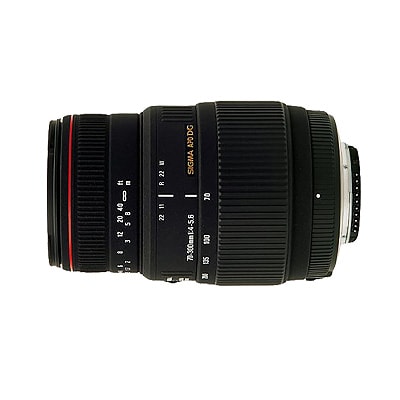
If you are on a low budget, then your options will generally be limited. Buying a wildlife telephoto lens is a good option in this case.
The Sigma 70-300mm f/4-5.6 DG APO Macro Telephoto Zoom Lens is a great multi-purpose lens that you can buy even when you do not have a lot of money to spend.
This is essentially one of the better budget-friendly telephoto lenses, which makes it a great option if you are looking to take shots of wildlife.
It also doubles as a zoom lens, with a fixed minimum focus distance of 37.4 inches, regardless of the zoom setting used.
The Sigma 70-300mm f/4-5.6 DG AO Macro Telephoto Zoom Lens is constructed with a multi-layer lens coating. The coating helps to reduce ghosting on your shots, while also minimizing flare – essential for any wildlife photographer.
It is compatible with a wide range of SLR cameras. There are separate models for Canon, Nikon, Samsung, Sony, and Sigma digital cameras. Pair it with good shutter speed for great results.
Best for Animal shots
Matching camera body: Canon EOS 6D Mark II DSLR
What we liked
- Telephoto lens
- Adjustable focal length range
- Aperture can be changed
- Multi-layer lens coating
- Multiple zoom settings
- APS-C size sensor
- Multifunctional lens
What we didn't like
- Somewhat heavy
- No autofocus
Focal length:70-300mm
Aperture:f/4-5.6
Format:APS-C
Type:SLR
Autofocus:No
Stabilization:No
Glass:14 lens elements, 10 groups
Weight:1.21 lbs
7. Sigma 500mm f/4 DG OS HSM Sports Lens
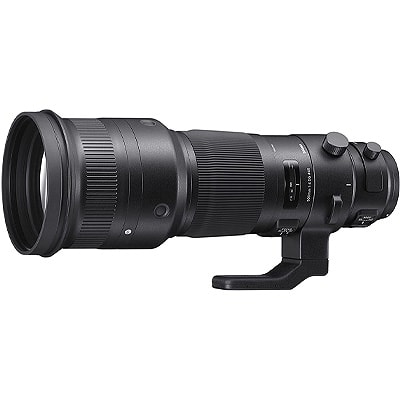
If you want something that the pros use and have a large budget to spend, then the Sigma 500mm f/4 DG OS HSM Sports Lens is an option that you want to look at.
While the price tag is high, the lens is able to outperform a lot of the competitor options that you will find.
It is one of the best lenses for wildlife. It does come with a heavier weight than competitors – so take this into account before making a purchase.
The lens is available in three models – for Canon, Sigma, and Nikon camera bodies.
The Sigma 500mm f/4 DG OS HSM Sports Lens features an impressive 500mm focal length. This means it is the perfect option for capturing large wildlife scenes.
It also doubles as a great lens for sporting events and even landscapes. The lens comes with a built-in image optical stabilizer system, as well as autofocus technology.
Best for: Large scenes, long ranges
Matching camera body: Canon EOS 6D Mark II
What we liked
- Hypersonic motor
- Autofocus
- Optical stabilizer
- 500mm focal length
- WR protector filter
- Compatible with teleconverters
- 3 different models available
What we didn't like
- High price tag
Focal length:500mm
Aperture:f/4
Type:Canon EF
Autofocus:Yes
Stabilization:Yes
Weight:7 lbs
Warranty:Yes
8. Canon EF-S 18-200mm f/3.5-5.6 IS Standard Zoom Lens
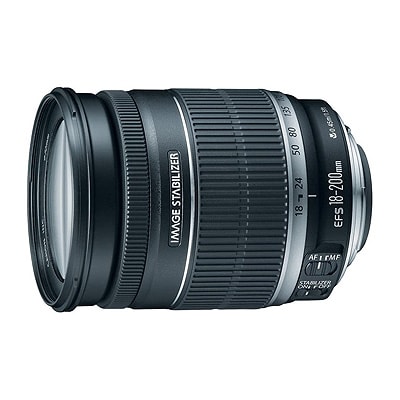
The Canon EF-S 18-200mm f/3.5-5.6 IS Standard Zoom Lens is our top selection. It is the best wildlife lens if you want something balanced.
While the focal length is a bit limited, this Canon wildlife lens is one of the best lenses that you can get for taking shots of animals at a closer range.
It comes with an adjustable focal length, which you can set between 18mm and 200mm.
At 200mm, the focal length offers a similar performance as a 320mm setting on a Canon APS-C camera. It is the best lens for wildlife photography Canon can offer for budget-conscious buyers.
These lenses for wildlife feature a 72mm filter, and the aperture can also be configured. The aperture rating ranges from f/3.5 to f/5.6. The lens comes with built-in image stabilization. The image stabilization works for up to four stops, which helps to reduce vibration and blurring.
There is also a micromotor-type autofocus system, further adding to the reasons why this is the best Canon wildlife lens on our list. This helps to improve the autofocus of your shot. The lens is compatible with APS-C Canon DSLR cameras. It also offers a maximum close-up magnification of 0.24x.
Best for: Close-ups, smaller animals
Matching camera body: Canon EOS 80D
What we liked
- Adjustable focal length
- Adjustable aperture
- 72mm filters
- Built-in autofocus
- Short minimum focus distance
- 0.24x magnification
- Image stabilization
What we didn't like
- Only four stops stabilization
- Limited focal length
Focal length:18-200mm
Aperture:f/3.5-5.6
Format:APS-C
Type:EF-S Mount
Autofocus:Yes
Stabilization:Yes
Weight:1.31 lbs
Warranty:Yes
9. Nikon 70-200mm f/4G ED VR Nikkor Zoom Lens
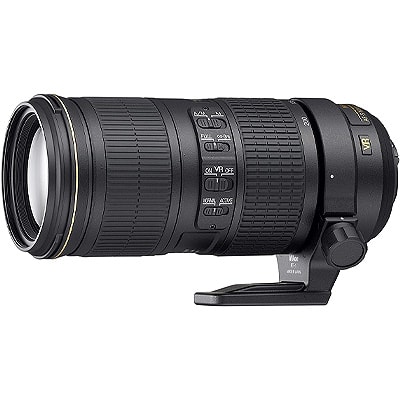
Next is the Nikon 70-200mm f/4G ED VR Nikkor Zoom Lens.
One of the greatest features of this Nikon wildlife lens is its wide compatibility.
It features compatibility with both FX and DX format Nikon camera bodies.
This ensures more photographers are able to take advantage of its features.
The focal length can be set between 70mm and 200mm.
While it is somewhat limited, the lens is great for taking close-ups of bigger animals in the outdoors. The Nikon 70-200mm f/4G ED VR Nikkor Zoom Lens offers multiple zoom options that you can choose from.
The lens also features a constant maximum f/4G aperture exposure setting. This means you have less worrying about getting the aperture right for your shot. A ring-type ultrasonic focus system is used.
These wildlife photography lenses also come with built-in vibration reduction. This helps to minimize ghosting when you take a shot of wildlife. It is the best Nikon lens for wildlife if you need something that won't break the bank.
Best for: All wildlife
Matching camera body: Nikon D750 FX-Format DSLR
What we liked
- Focal length can be adjusted
- FX and DX-format compatibility
- Lower weight
- 3 ED lens elements
- Multiple zoom settings
- Nano-Crystal coating
What we didn't like
- Focal length under 300mm
Focal length:70-200mm
Aperture:f/4G
Format:DX & FX
Type:ED VR Lens
Autofocus:No
Stabilization:Yes
Glass:3 ED lens elements, 1 HRI element
Weight:1.87 lbs
Warranty:Yes
10. Tamron 16-300mm F/3.5-6.3 Di-II VC PZD All-in-One Zoom Lens
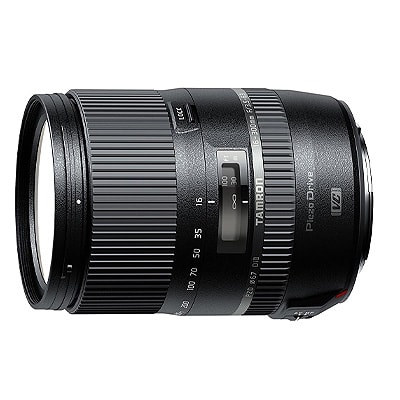
The Tamron 16-300mm F/3.5-6.3 Di-II VC PZD All-in-One Zoom Lens is an excellent option if you want an all-around lens that can be used for different types of photography sessions.
This is primarily a zoom lens, but the focal length can be adjusted to suit a variety of shooting modes.
It features an excellent zoom range. You can use the zoom lens to take shots of single animals or even groups of animals.
It is also a good option for taking landscapes with wildlife as the subject. The focal length of the lens can be adjusted from 16mm up to 300mm, depending on the shot you want to take.
It also features an aperture that can be adjusted from F/3.5 to F/6.3. The Tamron 16-300mm F/3.5-6.3 Di-II VC PZD All-in-One Zoom Lens comes with an ultrasonic motor. This feature of the best wildlife lens helps to provide better autofocus capabilities.
A vibration reduction system is also built into the lens. This reduces blurring and ghosting on shots caused by vibration.
Best for: Wildlife shots
Matching camera body: Canon EOS 90D
What we liked
- Focal range adjustable
- Aperture can be adjusted
- Multiple coatings
- Comes with lens hood
- Autofocus
- Vibration compensation
- Great all-around lens
What we didn't like
- Only one lens cap included
- Limited image stabilization features
Focal length:16-300mm
Aperture:F/3.6-6.3
Format:APS-C
Type:EF
Autofocus:Yes
Stabilization:Yes
Weight:1.29 lbs
Warranty:Yes
11. Nikon AF-P Nikkor 70-300mm f/4.5-5.6E ED VR Lens
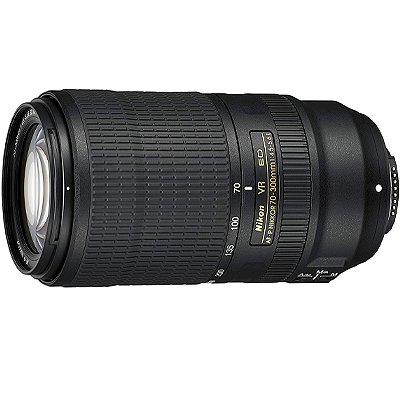
The Nikon AF-P Nikkor 70-300mm f/4.5-5.6E ED VR Lens is a great in-between lens for wildlife photographers who want range with their focal length, but don't want the burden of a large, heavy super-zoom telephoto lens.
This lens has a fast AF, which allows photographers to focus on their intended targets easily.
Its 4.5-step Vibration Reduction is also crucial to producing images unaffected by a shaky hand.
Intermediate wildlife photographers may find the Nikon AF-P Nikkor 70-300mm f/4.5-5.6E ED VR Lens a great option. It has a decent zoom but also allows users to back off the zoom and take wider photos to feature more of the background in their photos.
This lens is also a fairly small and lightweight telephoto zoom, making it a great option for photographers who prefer less weight when going out to shoot wildlife.
Best for: Wildlife Photography
Matching camera body: Nikon D7500 DX-Format DSLR Camera
What we liked
- Sharp Images
- Dynamic Zoom Range
- 4.5-step Vibration Reduction OS
- Full-frame Compatibility
- Compact, Lightweight Lens
- Fast and Quiet AF
- Weather Sealed
What we didn't like
- The AF-P is Incompatible with Older Nikon DSLR Cameras
- Not Enough Zoom for Serious Bird Photography
Focal Length: 70-300mm
Aperture: f/4.5-5.6E
Format: Full-Frame
Type: Fixed Zoom
Autofocus: Ultra-Fast, Near Silent AF
Stabilization: VR Image Stabilization
Glass: 1 Extra-Low Dispersion (ED) Glass Element
Weight: 1.5 lbs
Warranty: 1-year Limited Warranty
12. Nikon AF-S Nikkor DX 18-200mm F/3.5-5.6G ED VR II Lens
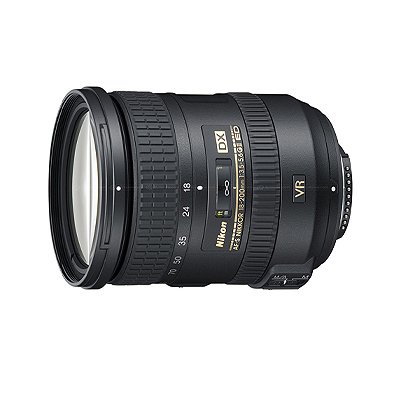
The Nikon AF-S Nikkor DX 18-200mm f/3.5-5.6G ED VR II Lens is a great option for wildlife photographers looking for a compact lens.
With a focal length of 18-200mm, you'll be able to take wide-angle 18mm shots, great for landscapes, and you'll also be able to zoom in on subjects.
Travelers may find this lens particularly enticing due to its size and its adaptability to different photography styles.
Though on the low end in terms of zoom, the Nikon AF-S Nikkor DX 18-200mm f/3.5-5.6G ED VR II Lens is still a serviceable wildlife camera capable of taking sharp photos at the full 200mm zoom. Wildlife photographers who like to feature animals with a full background may prefer this smaller lens.
Best for: Wildlife and Landscape Photography
Matching camera body: Nikon D7500 DX-Format DSLR Camera
What we liked
- Decent Range for Compact Telephoto Zoom
- Good Travel Lens
- Close Focus at 1.6 ft; Can Be Used as a Workable Macro Lens
- Maximum aperture f/3.5 to Perform Well in Low Light
- Autofocus allows M/A mode (A Great Feature for Wildlife Photography)
- Zoom Lock
- Vibration Reduction Keeps Images Stable
What we didn't like
- Lens Creep
- Limited Zoom at High Focal Length
Focal Length: 18-200mm
Aperture: f/3.5-5.6G
Format: DX
Type: Telephoto Zoom
Autofocus: Silent Wave Motor AF
Stabilization: Nikon VR II (Vibration Reduction) Image Stabilization
Glass: 2 Extra-Low Dispersion (ED) Glass Elements
Weight: 1.25 lbs
Warranty: 1-year Limited Warranty
What are you going to photograph?
When choosing the best lens for wildlife photography, it's important to consider what types of animals you are planning on photographing. There's a big difference between bird photography, wildlife photography, and macro photography. Finding a lens that suits your style is essential to producing the best images in your photo niche.
Bird Photography
Taking great photos of birds is an exhilarating experience. It's so hard to capture birds in the right moment because they're so quick and small. It's absolutely necessary for bird photographers to have a fast camera accompanied by a zoom lens. Bird photographers typically aim for a focal length of at least 400mm.
Wildlife Photography
Larger wildlife may not require as much zoom, but you'll still want to have a decent focal length in order to stay safe. Since wildlife can be so unpredictable, it's great to prioritize a telephoto zoom lens that has varying focal lengths and the best wildlife camera.
For a lighter lens, a focal length of 18-200mm would be a good option for wildlife at a reasonable distance or if you want to take pictures that incorporate wider shots. A 100-400mm lens is a good option for photographers wanting to respect the space between them and the animals they encounter.
Macro Photography
Some wildlife photographers prefer the "wildlife" that we overlook. Insects, spiders, lizards, and amphibians are great to capture on camera. Macro lenses allow photographers to record the minute details of these small creatures. If you're into nature on a micro level, then you'll need to opt for a macro lens.
Zoom lens vs. Prime lens
Wildlife photographers either use zoom lenses or prime lenses. There are pros and cons to each, so it's important to understand the features of both.
Zoom lens
A zoom lens is a lens that has a varying focal length, such as 70-300mm. This means that the lens can zoom from 70mm to 300mm.
The advantages of zoom lenses are numerous. Zoom lenses are very forgiving lenses. They are versatile and allow you the option to take photos close up or at a distant.
For most wildlife photographers, particularly enthusiasts or those who like to hike with their camera, the zoom lens is the way to go.
Prime lens
Prime lenses feature a fixed focal length, so it is not possible to adjust the crop of a photo with the lens itself. The benefit of a prime lens is its wide-open aperture.
Prime lenses are generally better at filtering light through the lens, which helps the camera take faster and sharper photos.
Prime lenses suited for wildlife photography will have a high focal length, such as 600mm, making these lenses quite large. Typically, these lenses usually require a tripod to work effectively.
The wildlife lens price timeline
The price of the best lens for wildlife photography is directly correlated with its size and the quality of glass it uses. Larger lenses, particularly telephoto zoom lenses, will be more expensive. Glass quality is another thing that drives the price up.
High-grade glass such ultra-low dispersion (UD) or fluorite will produce sharper images but will come at a higher cost. Below is a breakdown of what types of lenses you can expect at different price points:
$0-500: Lenses under $500 will have a low focal length, which is most often used for portrait photography. Some will have limited zoom capabilities, but most will be small prime lenses between 18 and 100mm.
$500-1,000: Wildlife photography enthusiasts can find decent lenses in this price range. Name brand optics such as Nikon or Canon may max out at a 300mm telephoto zoom, but other brands such as Tamron and Sigma offer 600mm zoom at this price point. Great lenses for wildlife will start in this price range.
$1,000-2,000: For more serious wildlife photographers, money spent on a lens is money well spent. Lenses between $1,000-2,000 offer a great range of focal length as well as reliably clear images at high zoom. Expect to find focal lengths such as 100-400mm or 200-500mm in this price range. You can find pro level lenses for wildlife in this price range.
$2,000-5,000: More specialized cameras that feature multiple UD or fluorite elements will come in at a price above $2,000. Photographers tend to pay for aperture here, opting for lenses, even zoom lenses, that have a very low f-stop.
$5,000-Higher: Lenses over $5,000 are professional grade. These lenses will produce impeccable images, but the high price certainly comes with a more specialized form of shooting.
Lenses such as the Nikon AF-S FX NIKKOR 500mm f/4E FL ED Vibration Reduction Fixed Lens or the Canon EF 500mm f/4L IS II USM Lens are both examples of high-end fixed aperture prime lenses (best for the money).
What about teleconverters?
Teleconverters are magnifying lenses that can be used to enhance the zoom of your original lens. So if you have a 70-300mm lens, you can use a 2x teleconverter to double the focal length range. To use a teleconverter, you simply place it between the camera body and the lens.
Teleconverters are a quick way to maximize zoom, but it comes with a cost. Though you'll be able to zoom in on subjects at a much greater level, the image quality of the photos you take will not be as sharp as images that you take without the teleconverter.
Photographers who prioritize zoom over image clarity may find teleconverters a great low-cost option as compared to purchasing a whole other lens for your camera setup. If you do opt for a teleconverter, don't skimp on a lower quality brand. The Canon EF 2X II Extender and the Nikon Auto Focus-S FX TC-20E III Teleconverter Lens are both excellent options depending on the type of camera you have.
How to choose the right lens for wildlife photography?
There are certain lens features that wildlife photographers prioritize. If you're in the market for a new lens, here are some features that shouldn't be overlooked.
Focal Length
A lens that can take pictures from a distance is a must. At a minimum, you'll want a 200mm lens for wildlife photography. For close-ups at a distance and bird photography, you'll need a lens with even more focal length, such as 400mm.
Autofocus
An autofocus that is fast and quiet is supremely beneficial to wildlife photographers. No matter the light conditions, you want your camera to be able to pick up the animals in your lens and focus on their features as they move about. Look for AF systems that include optimized image stabilization, a low f-number, and decent glass. All these components help contribute to the efficiency of the AF system.
Aperture
A wide-open aperture will help your camera perform well in low-light conditions. An aperture of f/2.5 is great, but most telephoto zoom lenses don't offer that range. Instead, shoot for a lens with an aperture of f/5 or less.
Size
Most wildlife photographers do extensive hiking with their camera gear. Most lenses for wildlife should be easier to carry if possible. If you want a smaller, more compact telephoto zoom lens, then you may want to stick with a 300mm lens or smaller. For those who love close, sharp pictures, be prepared to haul around a large piece of glass. Not all super-zoom lenses are a pain to carry, though. Some are actually built with balance in mind.
FAQ (Frequently asked questions)
What lens is best for wildlife photography?
The Nikon AF-S FX NIKKOR 200-500mm is the best (great value) lens to consider. It features built-in vibration reduction and autofocus functionality. It is compatible with Nikon DSLR cameras.
What is the best camera and lens for wildlife photography?
The Canon EOS 7D Mark II DSLR Camera, along with the Canon EF 100-400mm f/4.5-5.6L lens, is the best combination for wildlife photography. This allows for an adequate angle that will capture more of the scenery.
What is the best Nikon lens for wildlife photography?
The best Nikon lens for wildlife photography is Nikon AF-S NIKKOR 200-500mm because it offers a lot of value for that price point.
What is the best Canon lens for wildlife photography?
The best Canon lens for wildlife photography is Canon EF 100-400mm f/4.5-5.6L is II USM Lens because it offers a lot of value for that price point.
What is the best focal length for wildlife photography?
A good minimum focal length to aim for when buying a lens for wildlife photography is 300mm. Most photographers find that 500mm gives them the best experience.
Is a 300mm lens good for wildlife?
Yes. A 300mm focal length is generally considered the minimum a photographer should opt for when buying a lens that will be used for wildlife shots.
What lenses do professional wildlife photographers use?
Professional wildlife photographers use lenses like Canon EF 200-400mm f/4L IS USM and the Nikon AF-S FX NIKKOR 500mm lens.
Is 200mm enough for wildlife?
Yes, if you are a total beginner and it's your first lens. Most wildlife photographers find that 200mm focal length is a bit limited. Usually 300mm is recommended minimum.
What is the biggest Canon zoom lens?
The Canon EF 200-400mm f/4L IS USM is currently one of the biggest zoom lenses that you can buy for a compatible Canon camera.
Is 400mm enough for wildlife?
Yes, a 400mm focal length should be appropriate for most photographers who want to focus on wildlife sessions – a range that can go up to 500mm would also enhance your experience.
Best Camera And Lens For Wildlife Photography
Source: https://worldbirds.com/best-lens-for-wildlife-photography/
Posted by: baileyteplongues1974.blogspot.com

0 Response to "Best Camera And Lens For Wildlife Photography"
Post a Comment